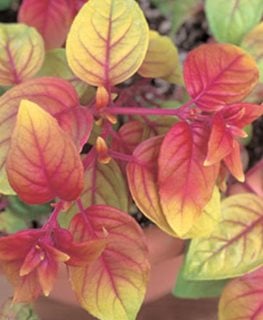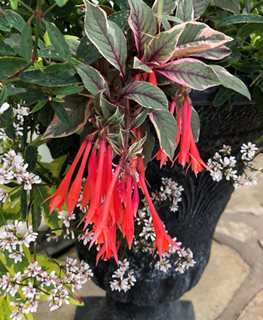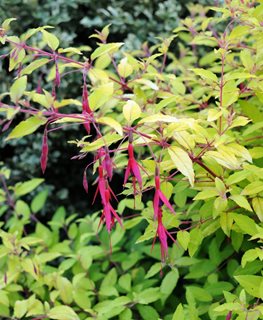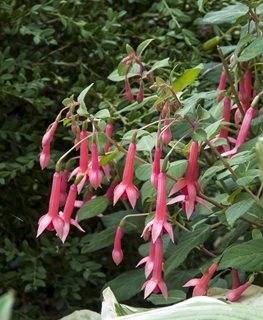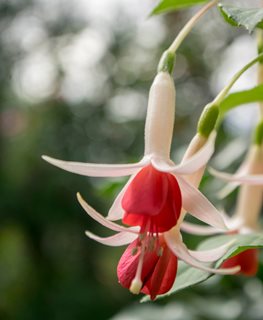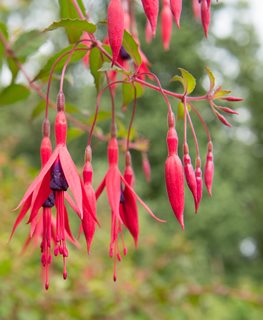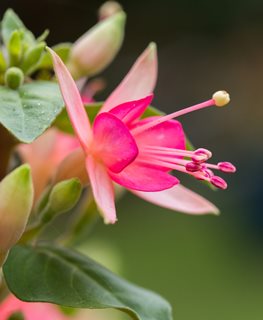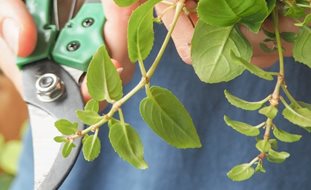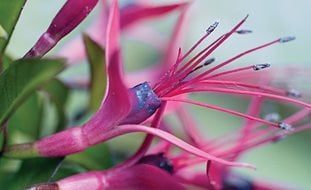How to Grow & Care for Fuchsia Flowers
Grow this versatile flowering plant to brighten up your yard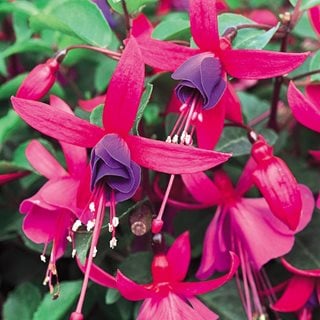
Shadow Dancers® 'Marcia'. Photo by: Proven Winners
Fuchsias are popular garden plants, revered for their exotic-looking blooms that dangle like decorative earrings. These long-blooming tender perennials are commonly grown in hanging baskets as a popular Mother’s Day gift, though there are many garden-worthy shrub types as well.
Also known as “lady’s earrings” or “lady’s eardrops,” Fuchsia are native to Central and South America, growing at higher altitudes where the air is cooler. There are over 100 species and thousands of varieties, with different sizes and growth habits suited to beds, borders, containers and hanging baskets. Here are some growing tips and how to use this versatile ornamental plant in your landscape.
On this page: Basics | Types | Planting | Care | Varieties | Frequently Asked Questions | Design Ideas
On this page:
- BASICS
- TYPES OF FUCHSIA PLANTS
- HOW TO PLANT FUCHSIAS
- FUCHSIA CARE
- FUCHSIA VARIETIES
- FREQUENTLY ASKED QUESTIONS
- DESIGN IDEAS
BASICS
Botanical name:
Fuchsia spp.
Plant type:
Deciduous or evergreen woody shrub grown as a perennial or annual
Hardiness Zones:
6-11, depending on the species or variety
Exposure:
Cool full sun to partial shade
Height/Spread:
4 inches to 6 feet tall, 1 to 6 feet wide. Climbers can reach 10 feet tall.
Growth habit:
Upright, bushy, trailing, or climbing habits
Bloom time:
Late spring to frost, depending on the variety and growing conditions
Flowers:
Fuchsia flowers, which range from 1/4 inch to several inches across, have flared petal structures called sepals that are slender and pointed. The corolla sits on top of the sepals, forming a tube around the stamens and pistils, and are single or double, rounded, or ruffly. Flowers come in a range of colors including white, pink, red, apricot, coral, orange, purple, and lavender, with single, double, or multi-colors. The sepal and corolla colors often contrast for a striking two-toned effect.
Foliage:
Fleshy leaves range from 1/4 inch to 10 inches long, averaging 1 to 3 inches long. Leaves are pointed or rounded, with smooth or serrated edges and a dull or shiny surface. Foliage is green, gold, chartreuse, bronze, burgundy, or variegated.
Benefits and other attributes:
Small berry-like seed pods ripen to burgundy-black after the flowers drop off. Both the berries and flowers are edible. Blooms are attractive to hummingbirds, butterflies, and other insect pollinators.
Are fuchsia plants poisonous?
All parts of the fuchsia plant are non-toxic to pets and children, though the ingestion of any ornamental plant may cause mild digestive upset.
TYPES OF FUCHSIA PLANTS
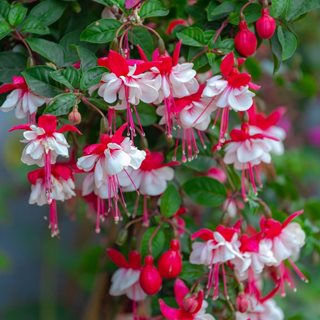
Photo by: Wut_Moppie / Shutterstock
There are different forms of fuchsias available to home gardeners.
- Trailing fuchsia has a trailing spreading habit that is ideal for hanging baskets and window boxes. These include many hybrid varieties and Fuchsia procumbens, a trailing species that can be grown as a ground cover.
- Upright fuchsia has a bushy or shrubby habit and is useful for garden beds and borders.
- Climbing fuchsia is a shrub with a vining habit that can be trained on a trellis, fence or other support.
- Standard fuchsia is a shrub trained into a tree form. Fuchsias can also be trained as topiary or bonsai specimens.
Fuchsia are often labelled as hardy, half-hardy or tender, depending on their growing zone. These are not hard and fast designations.
- Hardy varieties are loosely defined as those that can survive in USDA Zones 6-7.
- Half-hardy varieties are generally regarded as those that can survive in USDA Zones 8-9.
- Tender varieties varieties are only perennial in frost-free climates (USDA Zones 10-11) and include most trailing hybrids, which are commonly grown as annuals.
See also: 7 Species Fuchsia Plants to Try
HOW TO PLANT FUCHSIAS
When to plant:
Wait until all danger of frost is past in your area. Plant during spring in moderately cool weather to prevent heat stress.
Where to plant:
Place in a site that receives full sun to partial shade. In hotter climates, provide shade from hot afternoon sun. Too much shade will result in slower growth and fewer flowers.
How to plant:
Loosen soil in the planting area and amend with compost or other rich organic matter. When planting fuchsia in pots, use a prepared potting mix.
Dig a hole slightly wider and shallower than the root ball. Remove plant from the nursery container and loosen roots if potbound. Place plant in the hole so the top of the root ball is level with the surrounding soil. In colder climates, hardy shrub types can be planted 2 to 4 inches deeper in the ground to protect the root ball from hard winter freezes. Fill in the hole with soil, tamp down gently to remove air pockets, and water thoroughly. Add a layer of mulch around the base to suppress weeds, retain moisture and keep roots cool. Water regularly until established.
Soil:
Fuchsias prefer rich, well-draining soil. Amend soil with compost or other organic matter. For containers, use a high-quality all-purpose soil mix.
FUCHSIA PLANT CARE AND MAINTENANCE

Firecracker upright fuchsia. Photo by: Proven Winners
Temperature and humidity:
Fuchsias thrive in temperate climates with mild winters, cooler summers and high humidity. Regions of the Pacific Northwest, England, and coastal areas provide the most optimal growing conditions. Fuchsias dislike hot, dry climates. Ideal temperatures are between 55 to 80 degrees F, though some varieties are more heat tolerant. During hotter months, flowering may slow down or halt, picking back up again when cooler temperatures resume in late summer and early fall.
Watering:
Fuchsias perform best with regular water. Keep soil evenly moist but not soggy. Water when the top inch of soil feels dry to the touch. Plants will need more water during hot spells. Potted plants will need more frequent watering than those in the ground. Avoid overhead watering to reduce the risk of disease.
Amendments and fertilizer:
Fuchsias perform best with regular fertilizing. Feed plants every 2 weeks during spring and summer with a balanced liquid fertilizer such as fish emulsion or seaweed. Plants can also be fed weekly using fertilizer at half-strength. Taper off fertilizing as fall approaches.
Pruning and deadheading:
- For hardy and shrub fuchsias: Wait until early or mid-spring when new growth appears. If the plant dies back to the ground in harsh winters, cut back all dead growth to just above the ground. In milder winters, remove any dead or broken branches and cut branches back to where there is living growth. If you want to keep the plants smaller, you can also trim them by up to one-third of their size.
- For tender fuchsias: Young plants can be pinched back to promote more branching and blooms. Trim out any broken or damaged branches as needed. Deadhead spent flowers and berries to prolong bloom time.
Overwintering:
Tender fuchsias can be overwintered by bringing plants indoors for the winter. Hardy fuchsia plants can stay outdoors with protection. Read more on how to overwinter your fuchsia plants.
Propagating fuchsias:
Fuchsias can be propagated from seed or from cuttings. Learn how to propagate fuchsia plants.
Pests and diseases:
Fuchsias are susceptible to pests and diseases, particularly when not given optimal growing conditions. Pests include aphids, fuchsia gall mite, scale, spider mites, thrips and whitefly. Diseases include botrytis (gray mold), powdery mildew, root or crown rot, rust, smut, and verticillium wilt. Use neem oil or insecticidal soap as needed.
Are fuchsias deer resistant?
Fuchsias are somewhat deer resistant, though deer will feed on plants they wouldn’t otherwise if other food sources are scarce.
FUCHSIA VARIETIES
FREQUENTLY ASKED QUESTIONS
Do fuchsias grow back every year?
Winter hardiness depends on the variety. Hybrid fuchsias used for hanging baskets and containers are typically grown as annuals, lasting for just one growing season. Hardy fuchsias can come back as perennials in USDA Zone 6 or higher.
Do fuchsias like sun or shade?
Fuchsias do best with lots of cool light or partial shade, typically morning sun, and protection from hot afternoon sun in hotter climates.
Can fuchsias survive winter?
Hardy fuchsias can survive average winters in USDA Zones 6-7 or higher. Others are semi-hardy or tender. See more above on overwintering fuchsias.
IDEAS FOR USING FUCHSIA PLANTS
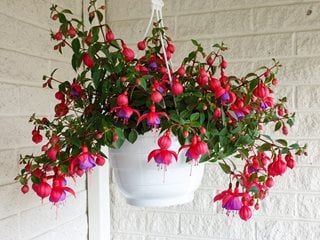
Photo by: Suratwadee Rattanajarupak / Shutterstock
There are many ways to use fuchsias in your garden. Here’s how:
For borders and landscapes: Shrub types can be planted in mixed or woodland borders and mass plantings. Climbing types can be planted along a trellis, arbor or fence.
For slopes and hillsides: Mass a shrub type along a slope for months of color and to help stem erosion.
For containers: Trailing types can be used in hanging baskets, window boxes, and other containers, by themselves or alongside other plants with similar growing needs.
- Plant fuchsias alongside plants such as angel wing begonia, coleus, and annual lobelia in beds or containers for months of continuous color.
- Plant trailing fuchsias in baskets and hang along a porch or pergola for a colorful display.
- Mass shrubby fuchsias along a slope or hillside by themselves or in combination with other plants with similar growing needs.
- Use shrub fuchsias to brighten up woodland or mixed borders in combination with other plants that bloom at different times for season-long color.
- Adorn window boxes or containers with trailing fuchsias combined with upright accent plants such as angelonia, lantana, or ornamental grasses and filler plants such as coleus, petunia, or pentas for a “thriller, filler, spiller” effect.
- Grow a taller shrub type in a row as hedging or screening along a fence or to divide garden rooms.
- Place a decorative container on a deck or patio and plant with fuchsias and other seasonal plants for close-up color.


